How Long Does Queso Last in the Fridge
Your refrigerated queso will last differently depending on whether it's store-bought or homemade. Store-bought queso, with its preservatives, can maintain quality for up to two weeks when stored properly in an airtight container below 40°F. However, homemade queso should be consumed within 3-5 days for ideal safety and taste. You'll want to monitor for signs of spoilage like unusual odors, texture changes, or visible mold. To maximize freshness, cool your queso to room temperature before refrigerating, and always use clean utensils when serving. For best results, label your container with the storage date and follow proper reheating techniques to maintain its creamy consistency. Understanding proper storage methods can greatly extend your queso's lifespan.
This post may contain affiliate links. If you make a purchase through these links, I may earn a commission at no additional cost to you. Additionally, portions of this post may be generated using artificial intelligence (AI) technology. While we strive for accuracy, please be aware that AI-generated content may not always be perfect and should be fact-checked when necessary.
The Spatula Scoops
- Store-bought queso can last up to 2 weeks in the refrigerator when properly stored due to added preservatives.
- Homemade queso should be consumed within 3-5 days for best quality and food safety.
- All queso must be stored in airtight containers at temperatures below 40°F (4°C) to prevent bacterial growth.
- Check for signs of spoilage like unusual odors, mold, slimy texture, or excess moisture before consuming stored queso.
- Peak freshness occurs within the first three days, after which texture and taste changes become noticeable.
Proper Queso Storage Guidelines
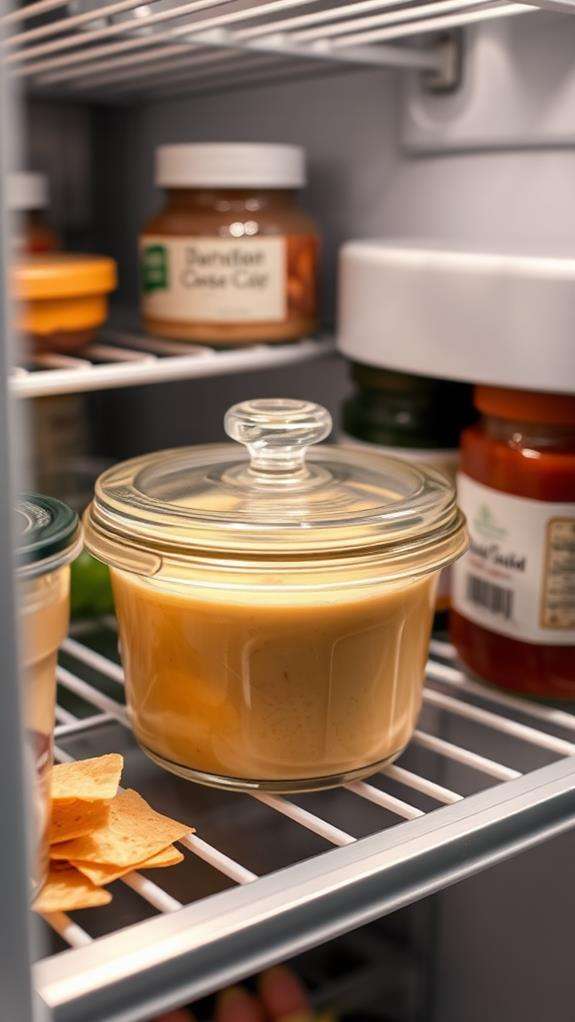
Proper queso storage begins with maintaining the right temperature and using appropriate containers. You'll want to store your queso in an airtight container to prevent moisture loss and keep it fresh in the fridge. Before refrigeration, let your queso cool to room temperature, as this step prevents unwanted condensation that could compromise its quality.
When you're ready to store your queso in the fridge, make sure the temperature stays below 40°F (4°C). This consistent temperature is essential for maximizing shelf life and preventing bacterial growth. Don't forget to label your container with the date you're storing it, as queso typically lasts 3-5 days when properly refrigerated.
Your storage container choice matters significantly. Consider using vacuum-sealed containers or high-quality airtight containers that can maintain a proper seal. If you're using plastic wrap or foil, make certain it's tightly secured to prevent air exposure. Proper storage isn't just about keeping your queso fresh – it's also about food safety. By following these refrigeration guidelines, you'll help prevent foodborne illness while maintaining your queso's texture and flavor throughout its shelf life.
The Five-Day Freshness Window
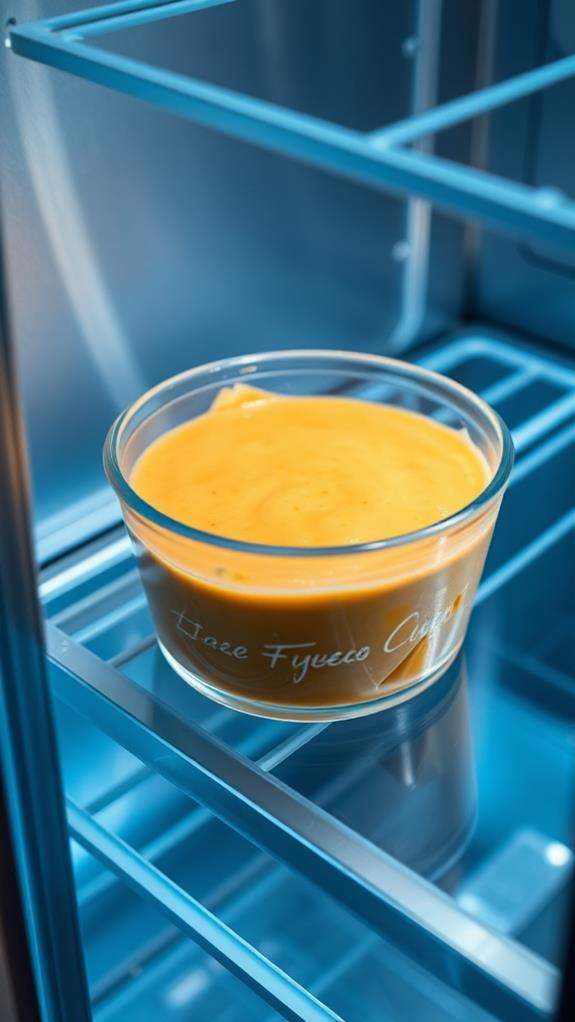
Throughout the five-day freshness window, your homemade queso undergoes subtle changes in texture and taste. You'll notice that the first three days offer peak freshness, making this the ideal time to enjoy your dip at its finest quality. When properly refrigerated in an airtight container, your queso maintains its creamy consistency and authentic flavor during this period.
As you approach days four and five, you'll need to pay closer attention to your queso's condition. While it's still safe to consume during this time, you might notice slight changes that require some intervention. You'll likely need to stir and reheat the queso to restore its original texture, as natural separation may occur. Before consuming queso that's been stored for four to five days, you should always check for unusual odors or changes in consistency. If you notice any slimy texture or off-putting smells, it's best to discard the queso immediately. To maximize your queso's shelf life throughout the entire 3-5 day window, remember to let it cool to room temperature before placing it in the refrigerator, as this prevents unwanted condensation from forming.
Signs Your Queso Went Bad
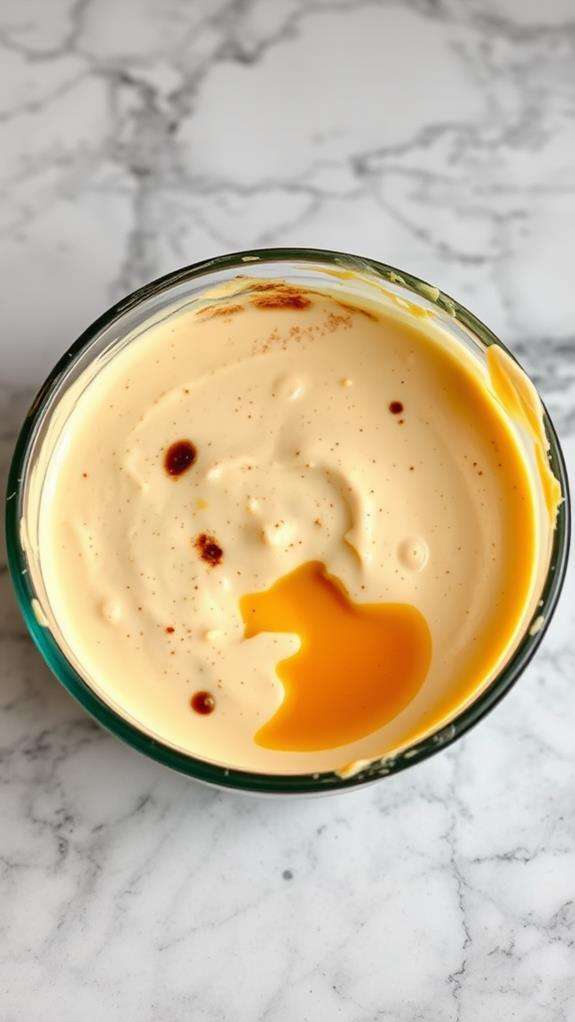
Awareness of spoilage signs can protect you from consuming unsafe queso. When you're checking your dip's shelf life, there are several key indicators that'll tell you if it's time to toss it out.
Your nose is one of your best tools for detecting when queso's starting to go bad. If you notice an off-putting or sour smell, that's your first warning sign. While inspecting queso, look carefully for any visible mold or unusual growths on the surface – if you spot even a tiny amount, you'll need to discard the entire container immediately. The texture can also reveal spoilage: if your once-smooth queso has become grainy or developed a slimy consistency, it's no longer safe to eat. Pay attention to moisture levels, too. When you notice excess moisture pooling on top or unusual dryness, these changes indicate deterioration. Since signs of spoilage typically develop after opening and storing for several days, you'll want to examine your queso thoroughly each time you use it. Don't take chances with questionable queso – when in doubt, it's safer to throw it out.
Best Reheating Methods
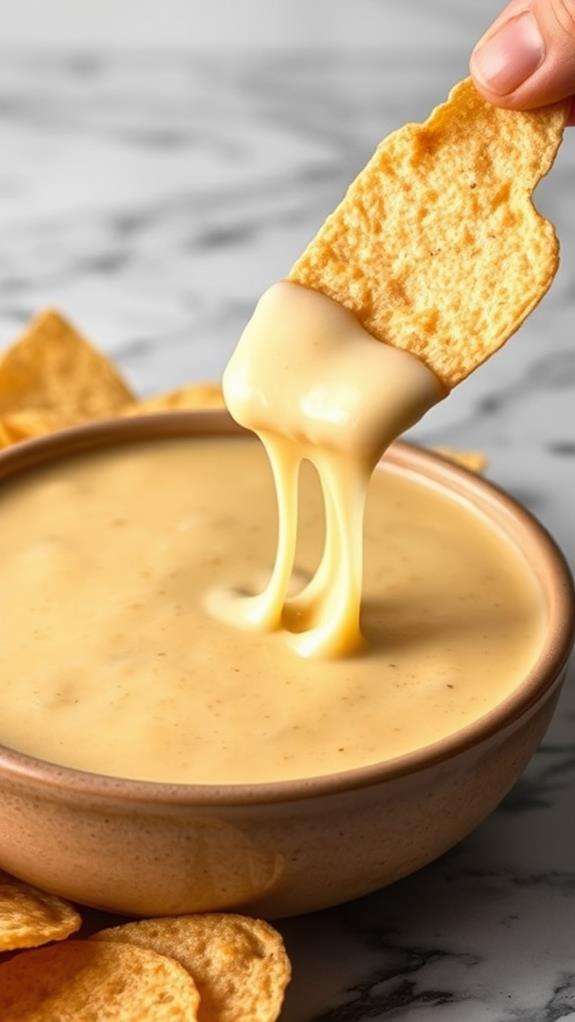
When choosing between microwave and stovetop methods for reheating your queso, you'll need to weigh convenience against control, as microwaving offers speed but requires careful 30-second intervals with stirring, while stovetop heating demands more attention but provides better temperature management. If you're using the microwave, always add a splash of milk and stir frequently to prevent that dreaded burnt cheese situation at the bottom of your bowl. The key to either method is maintaining a watchful eye and keeping the heat at medium-low, ensuring your queso reaches a safe 165°F while preserving its creamy texture.
Microwave Vs Stovetop Tips
Reheating leftover queso doesn't have to be a guessing game – both microwave and stovetop methods offer effective solutions with distinct advantages. When using the microwave method, transfer your queso to a microwave-safe bowl and heat it in 30-second increments, stirring between each interval to guarantee even heating. You'll want to add a splash of milk to maintain that smooth, creamy consistency you're looking for.
If you prefer more control over the heating process, the stovetop method might be your best choice. Place your queso in a saucepan over medium-low heat, stirring continuously to prevent the cheese from sticking or scorching. This method takes longer than microwaving but offers better temperature control and more consistent results. Remember to add a small amount of milk while stirring to achieve the desired texture.
Regardless of which method you choose, make certain your queso reaches 165°F (74°C) to ensure it's safe to eat. You'll know you've succeeded when the cheese is thoroughly heated and maintains its smooth, dippable consistency without any cold spots or burnt edges.
Preventing Burnt Queso
The key to perfectly reheated queso lies in preventing it from burning – a common issue that can ruin your cheese dip experience. Whether you're working with store-bought queso or homemade varieties that have been stored properly in airtight containers, proper reheating techniques are vital for maintaining quality.
To prevent overheating and guarantee your queso maintains its creamy texture, follow these proven methods:
- Use 30-second microwave intervals, stirring between each session
- Add a small amount of milk while reheating to maintain consistency
- Keep heat at medium-low when using the stovetop
- Monitor temperature closely and stir continuously
For larger quantities of tightly sealed leftover queso, your slow cooker becomes an invaluable tool. Set it to low heat and stir occasionally to achieve even warming without the risk of scorching. When reheating on the stovetop, never leave your queso unattended, as direct heat can quickly lead to burning. Remember that patience is important – rushing the reheating process often results in burnt spots or uneven warming. By following these careful heating methods, you'll preserve your queso's smooth texture and rich flavor.
Creative Leftover Queso Recipes

Resourcefulness shines when transforming leftover queso into exciting new dishes. While you're considering how long queso lasts in your fridge, you can prolong its shelf life by repurposing it in recipes that'll make your Mexican food adventures even more delightful. Your creamy cheesy dip doesn't have to be limited to chips and tortillas.
Transform your stored leftover queso into mouthwatering Queso Chicken Enchiladas, where the creamy layer of cheese creates an irresistible filling. If you're craving comfort food, try making Mexican Tater Tot Casserole by combining your queso with crispy tots and seasoned ground meat. For pasta lovers, Taco Stuffed Shells offer a creative fusion option, utilizing the queso as a rich sauce that perfectly complements the stuffed pasta shells.
You can also enhance your classic mac and cheese by incorporating leftover queso for an elevated Tex-Mex twist. For lighter options, don't hesitate to drizzle the queso over steamed vegetables like broccoli. These versatile applications guarantee you'll make the most of your leftover queso while maintaining food safety and maximizing flavor potential.
Store-Bought Vs Homemade Shelf Life
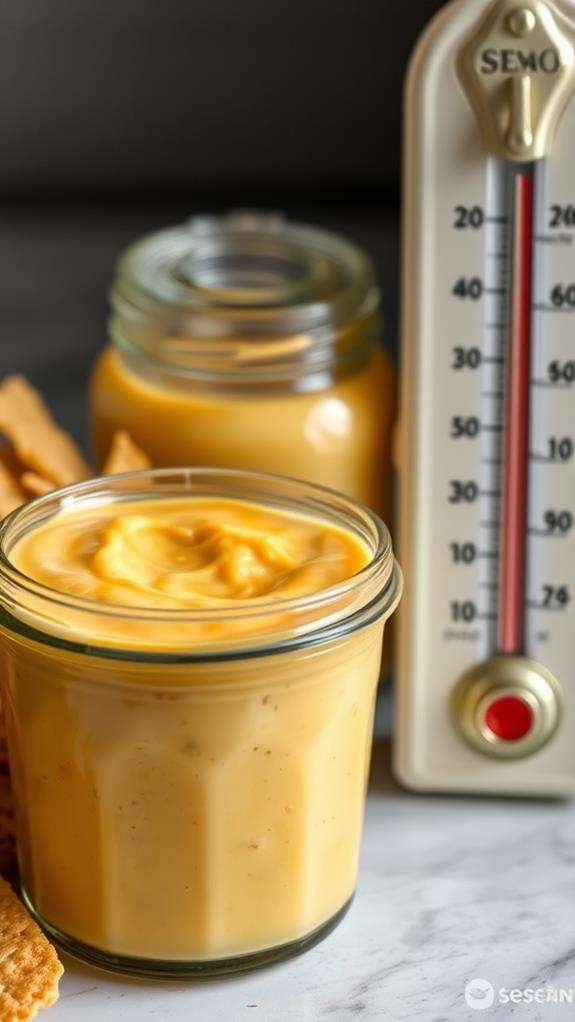
After exploring creative ways to use your leftover queso, understanding storage differences between store-bought and homemade varieties becomes your next priority. The shelf life of queso varies considerably depending on whether you've purchased a commercial product or made it from scratch in your kitchen.
Store-bought cheese dip typically lasts up to two weeks in your refrigerator, thanks to added preservatives that extend its shelf life. However, your homemade queso requires more careful attention, as it should be consumed within 3-5 days for ideal freshness. To maximize the longevity of both varieties, you'll want to follow these essential storage guidelines:
- Always store your queso in airtight containers to prevent bacterial growth
- Label containers with the preparation or purchase date
- Check the date on the packaging for store-bought versions
- Monitor for signs of spoilage like unusual odors or texture changes
Regardless of which type you're storing, proper container sealing is vital. When you're dealing with homemade queso, be especially vigilant about monitoring its condition after day three, as the lack of preservatives makes it more susceptible to spoilage compared to its commercial counterparts.
Extending Your Queso's Lifespan
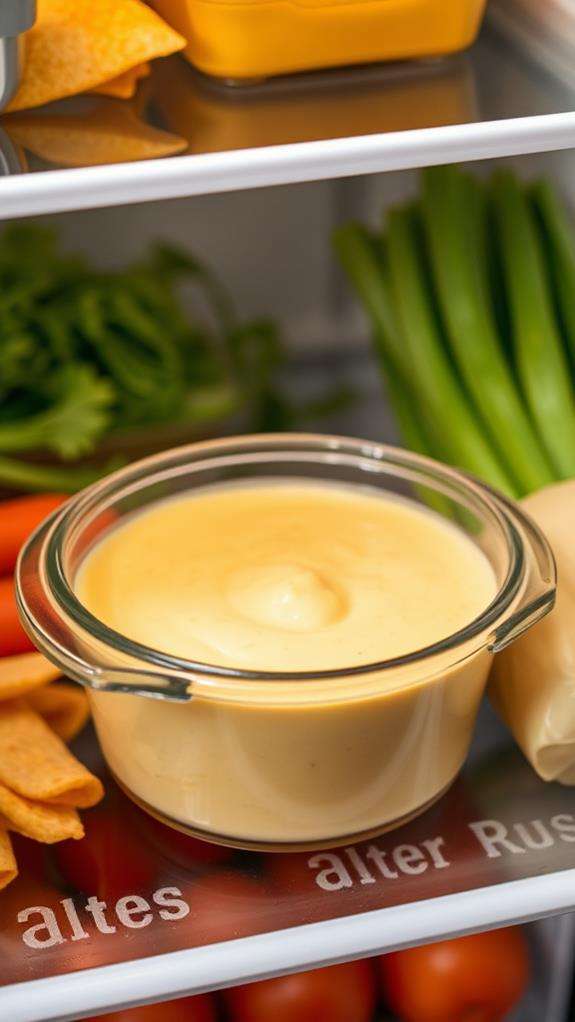
Making your queso last longer requires a few simple but essential steps that can greatly extend its shelf life. When storing queso, your primary focus should be on creating an airtight seal to prevent exposure to air and moisture, which are the main culprits behind quick spoilage. You'll want to transfer your queso into a container with a tight-fitting lid immediately after use.
For refrigerated queso, you can expect a lifespan of 3-5 days when properly stored, though store-bought versions may last up to two weeks due to added preservatives. To track freshness, always label your container with the storage date, and regularly check for any unusual odors or texture changes. When dealing with leftovers, you can maintain the queso's creamy consistency by adding a small amount of milk during reheating. This simple trick helps prevent the cheese from becoming too thick or grainy. While extending the shelf life of your queso is important, remember that even with perfect storage conditions, it won't last indefinitely. Your best approach is to consume it within the recommended timeframe while maintaining proper storage practices.
Frequently Asked Questions
How to Know if Queso Is Bad?
Your queso's gone from heavenly to questionable? Here's how to tell if it's spoiled. Trust your nose first – if there's a sour smell instead of that fresh dairy aroma, toss it out. Check the texture; if it's turned slimy or grainy instead of creamy, that's a red flag. Look for any spots of mold or discoloration, which mean it's time to say goodbye. And if it's been lurking in your fridge beyond 5 days, inspect it extra carefully.
Is Queso Good After a Week?
No, you shouldn't eat queso after a week in the fridge, even if it looks fine. While the cheese dip might appear normal, harmful bacteria can multiply beyond safe levels after 5 days. You're risking foodborne illness if you consume week-old queso. For your safety, it's best to follow the 3-5 day storage guideline and toss any leftover queso after that period, regardless of how it looks or smells.
How Long Is Opened Cheese Dip Good For?
"Better safe than sorry" when it comes to opened cheese dip. You'll want to consume it within 7 days of opening, even if it's stored properly in an airtight container in your fridge. Don't leave it at room temperature for more than 2 hours. While checking the expiration date helps, you should also watch for warning signs like unusual smells, mold, or changes in texture. When in doubt, throw it out.
How Long Is Queso Fresco Good for in the Fridge?
You'll need to consume your queso fresco within 3-5 days after opening it for the best quality and safety. If it's unopened, you've got the same timeframe of 3-5 days from the purchase date, as this fresh cheese doesn't contain preservatives. Keep it in an airtight container in your fridge, and don't leave it at room temperature for more than two hours. Always check for unusual smells or textures before eating.





